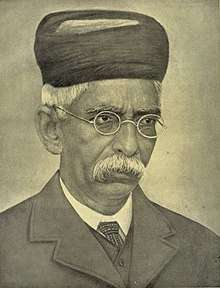Ramanbhai Neelkanth
Ramanbhai Mahipatram Nilkanth (Gujarati: રમણભાઈ મહીપતરામ નીલકંઠ) (13 March 1868 – 6 March 1928) was a Gujarati novelist, essayist, literary critic and politician from India. The Ramanlal Nilkanth Hasya Paritoshik is named after him.[1]
Rai Bahadur Sir Ramanbhai Nilkanth | |
|---|---|
 | |
| Native name | રમણભાઈ મહીપતરામ નીલકંઠ |
| Born | Ramanbhai Mahipatram Nilkanth 13 March 1868 Ahmedabad, Gujarat |
| Died | 6 March 1928 (aged 59) Ahmedabad |
| Occupation | Novelist, essayist, literary critic, and politician |
| Language | Gujarati |
| Nationality | Indian |
| Alma mater | |
| Period | Pandit Yuga |
| Notable works |
|
| Notable awards | Knighthood (1927) |
| Spouse | |
| Children | Vinodini Nilkanth, Sarojini Mehta |
| Relatives | Mahipatram Rupram Nilkanth (father) |
Life
Ramanbhai Nilkanth was born on 13 March 1868 in Ahmedabad to Mahipatram Rupram Nilkanth and Rupkunwarba who were social reformers. He completed his primary and secondary education in Ahmedabad. He matriculated in 1883. He joined Gujarat College, Ahmedabad in 1884 and completed his B.A. from Elphinstone College, Bombay in 1887 and later obtained his LL.B.[2] His first wife Hansvadan died at a young age and he married again to Vidyagauri Nilkanth, one of the first female graduates from state, in 1887. He worked as a clerk in the government office. He had later served as a Judge in Godhra.[2] He was awarded title of Rai Bahadur and later knighthood in 1927. He had also served as the mayor of Ahmedabad. He was also the first secretary of the Ahmedabad Red Cross founded in 1923. He had also served as the president of Gujarati Sahitya Parishad in 1926.[2]
He died on 6 March 1928 at Ahmedabad. His daughters Vinodini Nilkanth and Sarojini Mehta were also writers.[2] British travel writer Pico Iyer is his great-grandson.[3][4]
Works
His humour novel Bhadrambhadra (1900) was a satire on language and social puritans.[2] It is influenced by The Pickwick Papers and Don Quixote.[2] His other novel is Shodhma (1915, incomplete). He wrote classic play Raino Parvat (1914). Hasyamandir (1915, with Vidyagauri) is collection of humour essays. His works of criticism are Vakyapruththakruti ane Nibandh Rachana (1903), Saraswatichandra nu Avlokan and Hridayveenanu Avlokan.[2] Two volumes of Dharm Ane Samaj (1932, 1935) are his philosophical work discussing religion and society. Kavita Ane Sahitya is his four volumes on poetry and prose. The Volume 1 (1904) contains articles on prosody and rhetoric; Volume 2 (1904) contains articles on practical criticism; Volume 3 (1928) contains occasional lectures and essays and Volume 4 (1929) contains some poems, short stories and essays on humour. Gujaratno Sankshipta Itihas (Short History of Gujarat) and Vivahvidhi (1889) are his other works.[2] He also edited Gyansudha.[2][5] Through his criticism, he tried to formulate a theory of artistic and literary beauty, which was influenced by the theories of English critics of his time. [6]
References
- "Tarak Mehta gets an award from Gujarat Government". India New England News. 15 February 2017. Retrieved 1 September 2018.
- "રમણભાઈ નીલકંઠ (Ramanbhai Nilkanth)". Gujarati Sahitya Parishad (in Gujarati). Retrieved 20 February 2017.
- John, Paul (8 December 2013). "The itchy feet gene". The Times of India. Retrieved 20 February 2017.
- Chaudhari, Raghuveer; Dalal, Anila, eds. (2005). "લેખિકા-પરિચય" [Introduction of Women Writers]. વીસમી સદીનું ગુજરાતી નારીલેખન [20 Century Women's Writing's in Gujarati] (in Gujarati) (1st ed.). New Delhi: Sahitya Akademi. p. 351. ISBN 8126020350. OCLC 70200087.
- Das, Sisir Kumar (1991). History of Indian Literature: 1911-1956, Struggle for Freedom : Triumph and Tragedy. Sahitya Akademi. ISBN 978-81-7201-798-9.
- Majumdar, R. C., ed. (1981). British Paramountcy and Indian Renaissance, Part II. The History and Culture of the Indian People (2nd ed.). Bombay: Bharatiya Vidya Bhavan. p. 195. OCLC 779779752.
Further reading
- Parikh, Sukumar; Parikh, Shailaja Kalelkar (2013). Marching to a Different Beat: The Nilkanths of Gujarat. ISBN 978-93-82255-35-2.
External links
| Gujarati Wikisource has original text related to this article: |
- Ramanbhai Neelkanth on GujLit